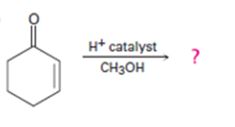
a)

Interpretation:
The products formed in the reaction given are to be identified. The mechanism of the reaction also is to be provided.
Concept introduction:
To identify:
The products formed in the reaction given and to provide the mechanism of the reaction.
b)

Interpretation:
The products formed in the reaction given are to be identified. The mechanism of the reaction also is to be provided.
Concept introduction:
Aldehydes and ketones react with alcohols in the presence of acids to yield hydroxyethers called hemiacetals. In the presence of acids the hemiacetal can react with another alcohol molecule to yield acetals. If the second alcoholic group is present in the same molecule, like in glycols and dihydric phenols, a cyclic acetal will result.
To identify:
The products formed in the reaction given and to provide the mechanism of the reaction.
c)

Interpretation:
The products formed in the reaction given are to be identified. The mechanism of the reaction also is to be provided.
Concept introduction:
Aldehydes and ketones react with alcohols in the presence of acids to yield hydroxyethers called hemiacetals. In the presence of acids the hemiacetal can react with another alcohol molecule to yield acetals. If the second alcoholic group is present in the same molecule, like in glycols and dihydric phenols, a cyclic acetal will result.
To identify:
The products formed in the reaction given and to provide the mechanism of the reaction.
d)

Interpretation:
The products formed in the reaction given are to be identified. The mechanism of the reaction also is to be provided.
Concept introduction:
α, β- Unsaturated ketones undergo conjugate (1,4-addition) addition reaction when treated with nucleophile to yield a saturated ketone as the product.
To identify:
The products formed in the reaction given and to provide the mechanism of the reaction.
Trending nowThis is a popular solution!

Chapter 19 Solutions
Organic Chemistry
- Predict the product(s) and provide the mechanism for each reaction below.arrow_forwardTreatment of (CH3)2CHCH(OH)CH2CH3 with TsOH affords two products (M and N) with molecular formula C6H12. The 1H NMR spectra of M and N are given below. Propose structures for M and N and draw a mechanism to explain their formation.arrow_forwardPredict the product and provide the mechanism for the reaction below:arrow_forward
